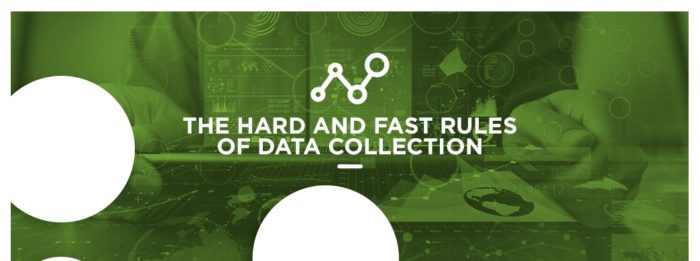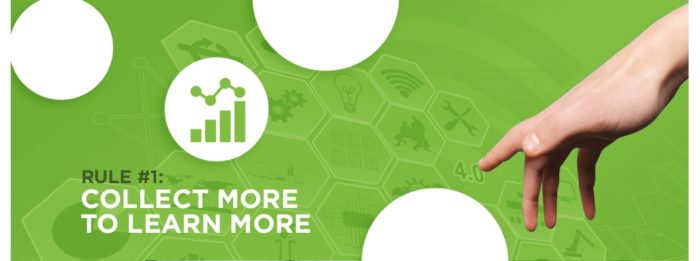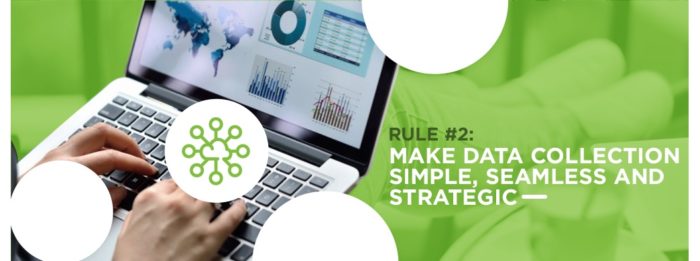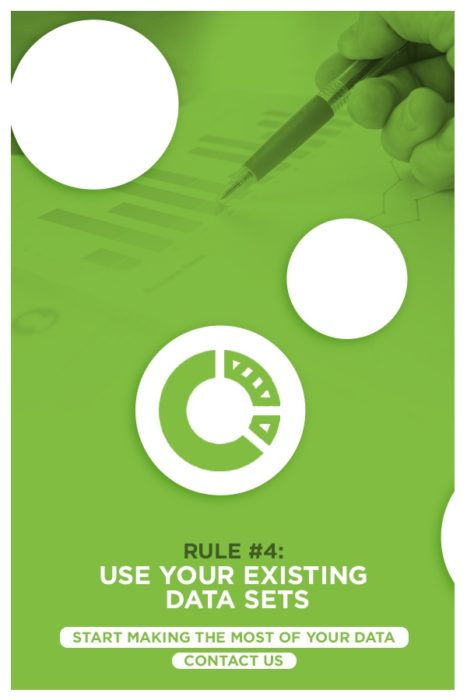
Jump to:
- Rule #1: Collect More to Learn More
- Rule #2: Make Data Collection Simple, Seamless and Strategic
- Rule #3: Take Your Data Collection Mobile
- Rule #4: Use Your Existing Data Sets
Every time someone views a page on your website, they generate as many as 40 different data points. That’s every page view and every person, whether they’re a first-timer or a repeat visitor. And if your data management platform (DMP) is working correctly, that means a lot of data collection.
Whether you’re at 10,000 page views a month or 100,000 per day, you’re likely amassing huge amounts of first-party data. It can be overwhelming to think about collecting all this data, let alone analyzing and activating it. That’s where Lotame comes in. We handle these data tasks so that our clients can access and act on their information to help grow their businesses.
Through our 10 years of experience helping clients collect, organize and make sense of their audience data, we’ve amassed a lot of information about how to make data collection easier and ensure it goes right. Here are four simple rules to keep in mind when collecting data from your websites, apps and other properties.
Rule #1: Collect More to Learn More

It stands to reason that the more data you have at your disposal, the deeper the insights you can gather about your audience. Today’s businesses have a huge array of potential sources of data. Lotame’s next-generation data management platform, Spherical can pull data from these various sources. With a DMP, all of this data is collected in one place and organized so that you can easily access it and make sense of it.
Learn About Our Award-Winning DMP
Data Sources
Some of the data sources you may have available to you include:
- Your websites: Lotame can help you collect data about who visits your websites and the actions they take while on your site.
- Your apps: Your DMP can also collect data about who downloads your app and how they use it.
- Ad campaigns: You can collect data about how people interact with ads on your site or ads you’ve placed on other sites.
- Social networking sites: Data about who follows you on social media and how they interact with you can be useful as can more general information about how your customers use social media.
- Your customer relationship management (CRM) system: A DMP can also pull data from your CRM so that all of your customer data is organized in one place.
- Point-of-sale data: If you have physical or e-commerce stores, you can also import this data into your DMP.
- Second-party sources: Everything we mentioned above is first-party data — data you collect yourself about your customers. Second-party data is someone else’s first-party data that they share with you.
- Third-party sources: You can also use third-party data, which you buy from data aggregators, to expand your dataset. You can purchase such data through the Lotame Data Exchange.
Data Points
Each source also has a lot of data you could potentially pull from it. The Lotame DMP can help you gather more data from each source so that you can get to know your audience better. On your website, for example, Lotame goes far beyond just collecting easy-to-find data such as URLs and metadata. Through our DMP, you can seamlessly collect numerous data points per page, including:
- Clicks
- Downloads
- Ad interactions
- Commenting
- Newsletter sign-ups
- Types of media being consumed
- Search terms being entered
- Forum posts and topics being created
Types of Insights
You can collect data about a wide range of topics using the sources listed above. This data might include information about your audience’s demographics, interests, values and the actions they take online. It’s important to collect a broad range of data so that you can get a more complete picture of who your audience is. The better you understand your data, the better you can tailor your interactions with them to their preferences. Personalizing your interactions in this way will improve your relationship with your customers.
Here are some examples of the data you can use:
- Age
- Gender
- Location or region
- Household income
- Marital status
- Family size
- Interests
- Values
- Preferences
- Opinions
- Browsing history
- Purchase history
- Social network use
If you’re a marketer, you could use this information to learn more about your audience, and target potential new customers who are similar to them. If you’re a publisher, you could divide your audience into segments based on their interests so that you can better target ads to them. The more information you have about your audience, the more accurate your audience profiles will be.
Rule #2: Make Data Collection Simple, Seamless and Strategic

It’s critical to have a data collection strategy in place before you start gathering data. Planning for data collection can help you to use your time and resources efficiently and ensure that you can achieve your data goals. Your data collection strategy should be simple, seamless and strategic. Our tools use approaches that align with these strategies and can make it much easier for you to implement your data collection plan. Here’s how to collect data using a data collection strategy.
Learn About Our Award-Winning DMP
Simple
You don’t want to spend all of your time managing data. If you do, it isn’t really useful. What you need is an efficient method for collecting, organizing and activating data that allows you to use it without draining your resources. Lotame’s DMP uses a unique rule-based approach to data collection. These rules are written into the program and enable the DMP to capture multiple data points from your digital properties with just a few simple steps. This reduces the amount of work you have to do manually and gives you more time to focus on your core business.
Seamless
To maximize the accessibility of your data, you want to be able to move it into and out of your DMP seamlessly. The Lotame DMP is designed to be able to gather data from multiple sources and organize it cohesively. It also allows you to export your data into other software programs without reformatting it. This will save you time and help ensure that you get as much benefit as possible from your data.
Strategic
Before you begin collecting data, decide what you want to accomplish with it. This objective will help guide the decisions you make throughout the data collection, organization and activation process. When determining whether you to collect a particular type of data, consider whether it will help you reach your business goals. You’ll also need to ensure that the data is accessible and high-quality, and tools like a DMP can help you with that.
Rule #3: Take Your Data Collection Mobile

There are more than 3.5 billion unique mobile internet users, and smartphone use accounts for 69 percent of media time for the average user. The number of mobile internet users is expected to reach 5 billion by 2025. That means that if you’re not including mobile data in your data collection strategy, you’re missing out on a huge amount of potential information.
Learn About Our Award-Winning DMP
Ways to Engage on Mobile
There are many different ways to engage with potential customers via mobile devices. Some examples include:
- Mobile Websites: Just like you can collect data from users who visit your website on a desktop computer, you can also gather valuable data when they visit it on a mobile device.
- Social Media Sites: Many people primarily use social media on their mobile devices. These sites offer an easy way to interact with customers.
- Company Apps: Creating a company app can help you to improve your relationships with your customers. With a DMP, you can gather information about when people download your app and how they use it.
- Mobile Ads: When users click on ads placed on mobile websites and apps, you can gather data that can help you to connect with them.
How to Collect Mobile Data
Lotame’s Spherical platform can collect data from a range of devices, including mobile websites and apps. We live in a multi-screen world, so online data collection needs to happen seamlessly across screens too. Our technology collects first-party data regardless of the device being used, whether it’s a desktop, smartphone or tablet.
Spherical can help unify, model, enrich, and activate known and unknown first-party customer data in smarter, faster, and easier ways. With connections to valuable data and activation, you can preserve and extend data connectivity and addressability in all environments.
Benefits of Mobile Data Collection
Users spend a lot of time on their mobile devices, so it’s vital that you take advantage of the data that mobile devices provide. Doing so helps you to get to know your audience better. If you don’t collect this data, you’re missing a significant chunk of information about your audience.
Linking devices using Lotame’s cross-device technology helps you to improve your knowledge of your audience even further because you can combine information from across each user’s various devices. It also enables you to serve sequential messaging across devices and target users with ads at the right time, no matter what device they’re using.
Additionally, mobile devices can offer information that other data sources don’t. Geotargeting, which involves targeting users based on their location, is one of the biggest advantages of mobile advertising. This allows advertisers to, for example, serve an ad for a restaurant when a user is physically near that restaurant. This is effective because users often use their smartphones to find stores, restaurants and other services when they’re on the go.
Rule #4: Use Your Existing Data Sets

Learn About Our Award-Winning DMP
We recognize that our clients have existing first-party data, and we want to ensure this data becomes actionable alongside data gathered from sites, apps and ads. First-party data is the information that an organization collects directly from its customers or audience. This can include data gathered from your website, mobile app or social media. It could also be information you have in your CRM and even offline data that you input into your DMP.
Customer data management platforms or DMPs can ingest first-party data that’s free of personally identifiable information from any source including email data, data housed on a CRM system or existing registration data. That way none of your first-party data goes to waste.
You also need to activate your data for it to be useful. Activation is the process of uncovering the value in your data by gathering insights from it and then putting those insights into action. Lotame’s next-generation data platform, Spherical, can help you to accelerate your customer data so that you can use it to meet your business goals.
The Importance of First-Party Data
First-party data can be some of the most valuable data to businesses, so it’s vital that it isn’t forgotten. Why is it so valuable? It’s from your audience or customers themselves, so it’s highly relevant. First-party data can help you to understand your existing audience. It’s also easy and low-cost to obtain it since you get it directly from your customers. Don’t leave your valuable data on the table — make sure you’re gathering it from every source. Because you know exactly where it came from, you know that it’s accurate, and there are minimal privacy concerns involved.
Uses of First-Party Data
Uncovering insights within first-party data helps you to get to know your audience better. This enables you to personalize your content for your audience. You can do this in a broad sense or on an individual level. If you’re a publisher and you realize your audience prefers video content over blog posts, you can adjust your content strategy to include more video. You could also personalize your site to individual users. Let’s say you know that a certain site visitor likes videos about sports. When that user visits your website, you could recommend sports videos to them. As another example, if a marketer sees that a user has several coffee makers in their online shopping cart, they may serve them ads for coffee makers.
First-party data can help you get to know your current audience. You can also combine this information with second-party and third-party data to help expand your audience. Lotame’s DMP and tools such as Syndicate and Lotame’s Data Exchange make it easy to collect these various types of data and then combine them in the DMP. You can also use the audience optimizer tool to find new potential customers who are similar to your current audience members.
First-Party Data Collection Best Practices
Keeping the following data collection tips in mind can help you get as much benefit as possible from your first-party data:
- Use your data strategy: Remember your data strategy when collecting first-party data. Doing so will help you collect data in a simple, seamless and strategic way. With a good data strategy, you’ll have enough data to uncover valuable insights without spending too much on data collection and management.
- Keep data raw: Thanks to low data costs, it’s now possible to store large amounts of raw data and not worry about compressing it. Storing raw data helps speed up analysis and ensure that you don’t accidentally get rid of information you may want in the future.
- Make privacy a priority: When dealing with data, it’s essential you follow all privacy rules. This will keep you out of legal trouble and improve your relationships with your customers or audience.
- Hire a data officer: Having clearly defined roles surrounding data can help ensure that it’s managed effectively and responsibly. You can hire a data officer or put a current employee in charge of data.
Start Making the Most of Your Data
Data collection is the first step in your successful data strategy, and Lotame offers one of the most robust data collection and management platforms in the industry. In addition to top-of-the-line technology, we also offer responsive customer service and support. Contact us or request a demo to find out more.